By Iris Biermann
Com4 Yarn is precisely a guarantee for success in practical application when the best yarn for the respective application is used. The 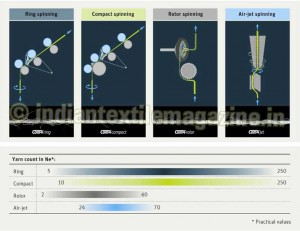 limitations and operating conditions must thereby be known.
limitations and operating conditions must thereby be known.
A look at practical application highlights further differences between the 4 spinning technologies. A decisive parameter for the selection of the suitable spinning process is the yarn fineness (Fig. 1).
Com4 ring has the greatest flexibility in the choice of the yarn count, and in practice the spinning range covers Ne 5 – 250. Com4 compact is seen in practice in the range of Ne 10 – 250. Com4 rotor is found rather in practice in the coarse range, from Ne 2 to Ne 60. However, Ne 60 can only be produced with microfibers.
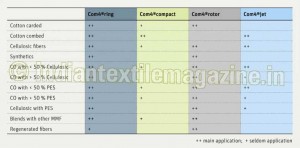 Com4 jet is currently still limited as regards yarn count. Today, Ne 24 – Ne 70 is being spun in practice. Ne 70 is also only produced with microfibers, as the minimal number of fibers in the yarn cross-section should not be less than approx. 95 fibers.
Com4 jet is currently still limited as regards yarn count. Today, Ne 24 – Ne 70 is being spun in practice. Ne 70 is also only produced with microfibers, as the minimal number of fibers in the yarn cross-section should not be less than approx. 95 fibers.
The choice of raw material and yarn type depends on the question of how the spinning process deals with the characteristics of the fiber material as well as the combination of fiber property and yarn structure (Fig. 2).
Carded cotton is mainly processed to Com4 ring and Com4 rotor yarns. Combed cotton is processed to Com4 ring, Com4 compact and 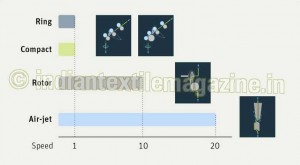 Com4 jet yarns. With Com4 rotor there is no point in using combed feeds, as the required volume and the yarn structure is removed from the yarn without creating additional new benefits.
Com4 jet yarns. With Com4 rotor there is no point in using combed feeds, as the required volume and the yarn structure is removed from the yarn without creating additional new benefits.
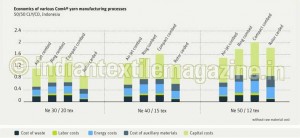 Cellulose fibers such as Viscose, Modal or Lyocell are processed in practice from Com4 ring, Com4 rotor and Com4 jet. Cellulose fibers or synthetically produced fibers lead to such high yarn tenacities and low hairiness values that a compacting process brings no benefits to Com4 ring yarn in the majority of cases. The consequence: in practice the raw material is seldom processed to compact yarns.
Cellulose fibers such as Viscose, Modal or Lyocell are processed in practice from Com4 ring, Com4 rotor and Com4 jet. Cellulose fibers or synthetically produced fibers lead to such high yarn tenacities and low hairiness values that a compacting process brings no benefits to Com4 ring yarn in the majority of cases. The consequence: in practice the raw material is seldom processed to compact yarns.
Synthetic fiber materials are implemented with Com4 ring and Com4 rotor. Com4 jet is still in the development stage with regard to  these applications. If, however, the synthetic proportion is smaller than 50 per cent, then Com4 jet is also a possible application.
these applications. If, however, the synthetic proportion is smaller than 50 per cent, then Com4 jet is also a possible application.
With regenerated fibers that are characterized by high trash contents and high proportions of short fibers, the Com4 rotor process clearly dominates. No other spinning technology can extract trash so well during the spinning process and use short fibers as filling fibers in the yarn cross-section.
Speed is not everything
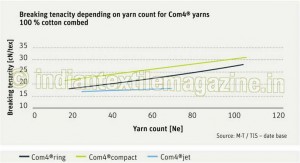 Independent of the raw material and yarn fineness, a clear difference is apparent between the processes (Fig. 3):
Independent of the raw material and yarn fineness, a clear difference is apparent between the processes (Fig. 3):
• Com4 rotor is 10 times quicker than ring and compact
• Com4 jet is 20 times quicker than ring and compact
Alongside many other influencing factors, this is naturally reflected in the yarn manufacturing costs.
The different processes have different yarn manufacturing costs. In the graph the manufacturing costs are shown, taking into account 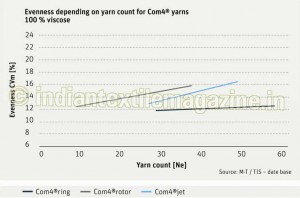 the costs for personnel, energy, consumable material, capital and waste, but, however, without raw material costs using Tencel / Cotton in the count ranges Ne 30 / 20 tex; Ne 40 / 15 tex und Ne 50 / 12 tex. The cost differences between the yarn types fluctuate according to the yarn counts (Fig. 4).
the costs for personnel, energy, consumable material, capital and waste, but, however, without raw material costs using Tencel / Cotton in the count ranges Ne 30 / 20 tex; Ne 40 / 15 tex und Ne 50 / 12 tex. The cost differences between the yarn types fluctuate according to the yarn counts (Fig. 4).
For decades, test results derived by the customer technology from practical applications as well as findings from tests in the SpinCenter have been collected worldwide in a central database. This accumulated knowledge helps to assess the 4 spinning systems from Rieter. Fig. 5 to Fig. 7 show extracts from the Rieter yarn statistics. The graphs emphasize Rieter’s technological know-how.
 Many quality parameters are strongly dependent on the yarn fineness as well as on the raw material used. It is clearly seen that due to the yarn properties, typical areas of application in relation to the yarn count of each yarn type have emerged in practice. For instance, rotor yarn with numerous positive yarn characteristics, especially in the coarse count range.
Many quality parameters are strongly dependent on the yarn fineness as well as on the raw material used. It is clearly seen that due to the yarn properties, typical areas of application in relation to the yarn count of each yarn type have emerged in practice. For instance, rotor yarn with numerous positive yarn characteristics, especially in the coarse count range.
The shortest process in comparison is used for the manufacture of Com4 rotor yarns, followed by Com4 jet, Com4 ring and Com4 compact (Fig. 8).
As the only textile machine manufacturer worldwide, Rieter provides competent advice for the entire spinning plant. Command of all 4 spinning processes alone allows neutral recommendations tailor-made to the individual requirements of the customer.